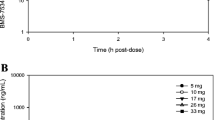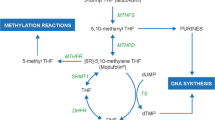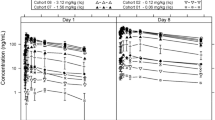Summary
Trimetrexate glucuronate (TMTX), a non-classic folate antagonist, has been evaluated clinically on several schedules. We studied TMTX given as an i.v. bolus over 5–30 min every 3 weeks in 44 patients with advanced solid tumors; it was given at doses ranging from 20 to 275 mg/m2. The maximal tolerated dose (MTD) on this schedule is 220 mg/m2, which we also recommend as a starting dose for phase II studies in patients without extensive prior therapy. Because of wide individual differences in drug tolerance, dose escalation in 25% increments is recommended for non-toxic patients. The principal dose-limiting toxicity was myelosuppression, although in some patients a flu-like syndrome precluded dose escalation. Significant rash and mucositis also frequently occurred in toxic patients. TMTX plasma concentrations were measured after the first dose and the data were fit by two-or three-compartment mammillary pharmacokinetic models. The TMTX clearance rate was 36.5±21 ml/min per m2 and did not change with dose; non-linearities with increasing dose were apparent in the steady-state volume of distribution (VSS) and in the terminal disposition half-life (t 1/2). The difference between pre-treatment and nadir leucocyte counts was correlated with TMTX dose (r=0.58; P=0.0006) and with the area under the concentration vs time curve (AUC) (r=0.41; P=0.02). Pre-treatment plasma albumin concentrations correlated weakly with the nadir white blood count (r=-0.36; P=0.047). Optimal schedules for the administration of TMTX have not been established and phase II trials using both bolus and daily x5 schedules are under way.
Similar content being viewed by others
References
Balis FM, Lester CM, Poplack DG (1986) Pharmacokinetics of trimetrexate (NSC 352122) in monkeys. Cancer Res 46: 169
Bertino JR, Sawicki WK, Moroson BA, Cashmore AR (1979) 2,4-Diamino-5-methyl-6-[(3,4,5-trimethoxcyanilino)methyl] quinazoline (TMQ), a potent non-classical folate antagonist: I. Effect on dihydrofolate reductase and growth of rodent tumor in vitro and in vivo. Biochem Pharmacol 28: 1983
Bertino JR, Sobrero A, Mini E, Moroson BA, Cashmore A (1987) Design and rationale for novel antifolates. NCI Monogr 5: 87
Chabner B (1982) Pharmacologic principles of cancer treatment. W. B. Saunders, Philadelphia, p 236
Diddens H, Niethammer D, Jackson R (1983) Patterns of cross-resistance to the antifolate drugs trimetrexate, metoprine, homofolate, and CB3717 in human lymphoma and osteosarcoma cells resistant to methotrexate. Cancer Res 43: 5286
Drake JC, Allegra CJ, Curt GA, Chabner B (1985) Competitive protein-binding assay for trimetrexate. Cancer Treat Rep 69: 641
Eisenhauer EA, See BC, Pater JL, Walsh WR (1988) Trimetrexate: predictors of severe or life-threatening toxic effects. J Natl Cancer Inst 80: 1318
Fanucchi MP, Walsh TD, Fleisher M, Lokos G, Williams L, Cassidy C, Niedzwiecki D (1987) Phase I and clinical pharmacology of trimetrexate administered weekly for three weeks. Cancer Res 47: 3303
Fry DW, Jackson RC (1986) Membrane transport alterations as a mechanism of resistance to anticancer agents. Cancer Surv 5: 47
Gibaldi M, Perrier D (1982) Pharmacokinetics. Marcel Dekker, New York, pp 445–449
Grem JL, Ellenberg SS, King SA, Shoemaker DD (1988) Correlates of severe or life-threatening toxic effects from trimetrexate. J Natl Cancer Inst 80: 1313
Grochow LB, Noe DA, Dole G, Rowinsky EK, Ettinger DS, Graham ML, McGuire WP, Donehower RC (1989) A phase I trial of trimetrexate glucuronate (NSC 352122) on a 5 day bolus schedule: clinical pharmacology and pharmacodynamics. J Natl Cancer Inst 81: 124
Heusner JJ, McCormack JJ (1981) Enzymatic assays for 2,4-diamino-5-methyl-6-[(3,4,5-trimethoxyanilino)methyl]quinazoline, a promising new “nonclassical” antifolate. J Pharmacol Sci 70: 827
Ho DHW, Covington WP, Legha SS, Newman RA, Krakoff IH (1987) Clinical pharmacology of trimetrexate. Clin Pharmacol Ther 42: 351
Hryniuk WM (1987) Average relative dose intensity and the impact on design of clinical trials. Semin Oncol 14: 65
Jackson RC, Fry DW, Boritzki TL, Besserer JA, Leopold WR, Sloan BJ, Elslager EF (1984) Biochemical pharmacology of the lipophilic antifolate trimetrexate. Adv Enzyme Regul 22: 187
Jackson RC, Leopold WR, Hamelehle KL, Fry DW (1988) Preclinical studies with trimetrexate: a review of conclusions and unanswered questions. Semin Oncol 15[Suppl 2]: 1
Jolivet J, Landry L, Pinard M-F, McCormack JJ, Tong WP, Eisenhauer E (1987) A phase I study of trimetrexate, an analog of methotrexate, administered monthly in the form of nine consecutive daily bolus injections. Cancer Chemother Pharmacol 20: 169
Reference deleted
Kamen BA, Eible B, Cashmore AR, Bertino JR (1984) Uptake and efficacy of trimetrexate TMQ. Biochem Pharmacol 33: 1697
Legha S, Tenney D, Ho DH, Krakoff I (1985) Phase I clinical and pharmacological study of trimetrexate (TMQ). Proc Am Soc Clin Oncol 4: 48
Lin JT, Bertino JR (1987) Trimetrexate: a second generation folate antagonist in clinical trial. J Clin Oncol 5: 2032–2040
Lin JT, Cashmore AR, Baker M, Dreyer RN, Ernstoff M, Marsh JC, Bertino JR, Whitfield LR, Delap R, Grillo-Lopez A (1987) Phase I studies with trimetrexate: clinical pharmacology, analytical methodology, and pharmacokinetics. Cancer Res 47: 609
National Cancer Institute (1983) Trimetrexate glucuronide (NSC 352122). NCI Clinical Brochure, Bethesda, Md
O'Dwyer PJ, Shoemaker DD, Plowman J, Cradock J, Grillo-Lopez A, Leyland-Jones B (1985) Trimetrexate; a new antifol entering clinical trials. Invest New Drugs 3: 71
Oken M, Creech R, Tormey D, Horton J, Davis TE, McFadden ET, Carbone PP (1982) Toxicity and response criteria of the Eastern Cooperative Oncology Group. Am J Clin Oncol 5: 649
Reece PA, Morris RG, Bishop JF (1987) Pharmacokinetics of trimetrexate administered by five-day continuous infusion to patients with advanced cancers. Cancer Res 47: 2996
Stewart JA, McCormack JJ, Tong W, Low JB, Roberts JD, Blow A, Whitfield LR, Haugh LD, Grove WR, Lopez AJG, DeLap RJ (1988) Phase I clinical and pharmacokinetic study of trimetrexate using a dailyx5 schedule. Cancer Res. 48: 5029
Author information
Authors and Affiliations
Additional information
Supported in part by NCI Contract, NCI-CM-47663
Rights and permissions
About this article
Cite this article
Grochow, L.B., Noe, D.A., Ettinger, D.S. et al. A phase I trial of trimetrexate glucuronate (NSC 352122) given every 3 weeks: clinical pharmacology and pharmacodynamics. Cancer Chemother. Pharmacol. 24, 314–320 (1989). https://doi.org/10.1007/BF00304765
Received:
Accepted:
Issue Date:
DOI: https://doi.org/10.1007/BF00304765




